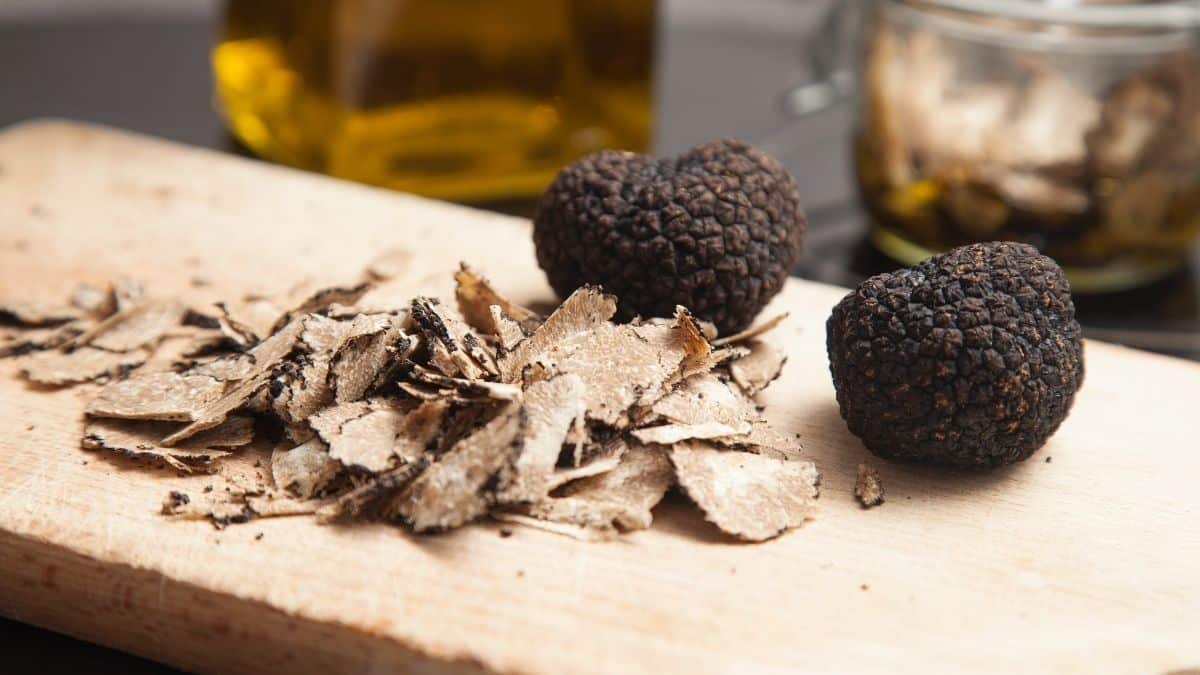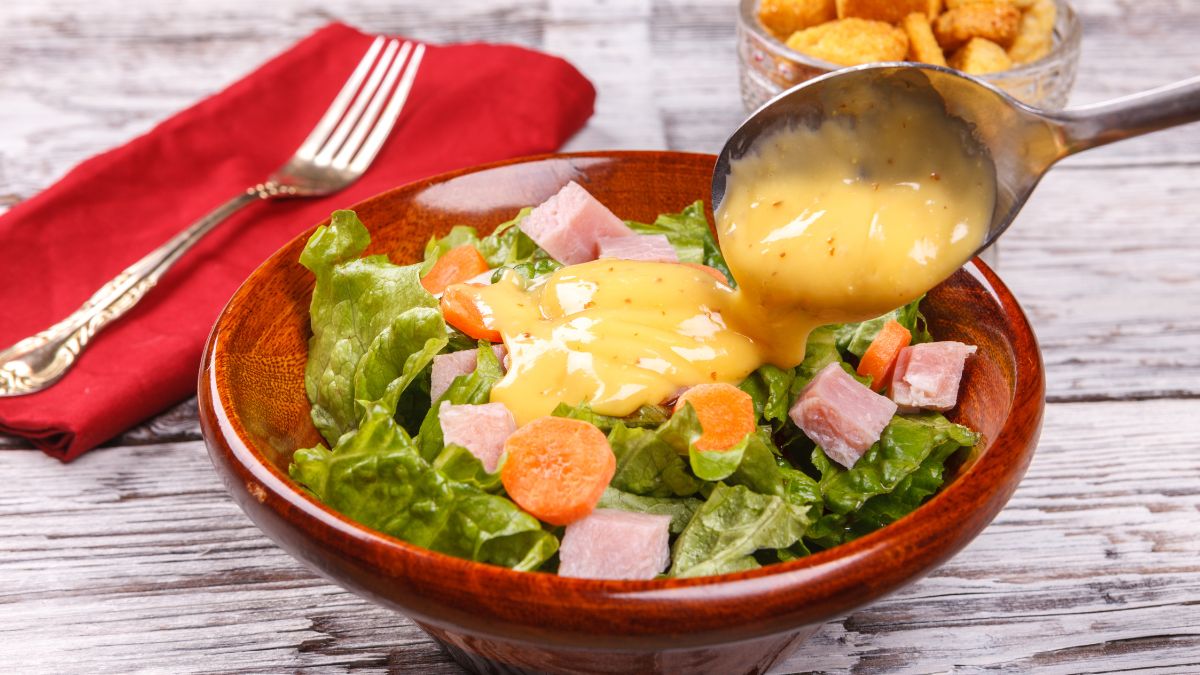Answer: Yes, vegans can eat truffles. But there are a few issues with the supply chain to understand first.

Truffles are a delicious yet expensive addition that works in almost any dish. While truffles don’t contain animal products, it is crucial to understand where they come from before using them in a vegan recipe.
Table of Contents
Are Truffles Vegan?
- Truffles contain no animal products.
- Working animals are used to harvest truffles.
- Truffles grow in specific regions with an unsustainable supply chain.
- Truffles have a unique, rich flavor and many health benefits.
What Are Truffles?
First, let’s clarify that this article is not about chocolate-coated ganache balls. Those usually are not vegan since ganache is made from chocolate and heavy cream. The valuable, edible fungi are what those confections are named after.
Musky and aromatic, these pungent fungi can punch up a dish and take it to a new status level. The subtle, smooth flavors are sometimes compared to garlic without the spicy kick. The natural flavor profile of truffles layers well with other subtle and delicate ingredients, making it a great addition to many traditional European recipes.
Truffles grow on the earth under very specific conditions. They are hard to find in the wild and incredibly difficult to grow on purpose. Finding these small, dark nuggets of rich flavor hidden in the ground is next to impossible for humans, and this is where the caveat for vegans comes in. Traditionally, and still to this day, truffles are hunted using a working animal with a keen nose, like a dog or a trained pig.
Truffle hunters are prized for their success at unearthing tons of value for their humans. The price of truffles, which will be explained thoroughly, can be life-changing if you can find a few pounds. Due to their contribution, these dogs and hogs are treated well and kept in good condition. Still, some strict vegans are against animal labor, even if it doesn’t involve harvesting the animal’s direct products.
Since truffles are wild fungi, they are even more sustainable than other horticulture products, like almonds. Truffles can provide rich, unmatchable flavor and a whole host of essential nutrients, which can be a great way to add flavor to dishes while improving your diet.
Where Do They Grow?
Truffles have baffled scientists and farmers for as long as people have been eating them. Truffles result from complex interaction and symbiosis with certain species of trees and the microbes in the soil. They can be found in many temperate regions like some European countries, North America, Australia, and some parts of southern Africa. That sounds like a lot, but maps of truffle ranges show they do much better in certain zones.
Some small commercial success has been had by farmers attempting to grow truffles. However, because only specific types of trees will allow truffles to grow, these growing operations must also change the trees in the landscape. Unfortunately, even truffle-growing operations mostly use dogs to track their truffles’ presence and growth and to locate them when it is time to harvest.
Source of Truffles
Buying truffles in their natural form can be costly. Even the low-end truffles can be $250 per pound.
France is responsible for 45% of the world’s truffle production and is home to mafficulteurs. These people who plant trees and pray for fungus can spend years waiting for some to grow alongside their trees.
Chefs, restaurants, and foodies all know the truffle as the “diamond of the kitchen” because of its high price and rarity. The most prized variety is the white truffle; in some cases, it has sold for $75,000 per pound.
With almost all sources of truffles being located in Europe, the distribution costs and environmental impact can also be a factor that discourages people on a vegan diet from trying them. However, you shouldn’t automatically turn away if you find yourself at a top-rated restaurant with vegan options that include truffles.
Working Animals
The working animals that are used for hunting truffles are dogs and pigs.
Dogs need to be trained, but pigs can innately seek out truffles. Truffles contain a hormone that is also part of the male pig’s saliva. The female hogs used to hunt truffles must be stopped quickly before they devour the profit.
Italy went so far as outright to ban truffle hogs in 1985. However, this was more to protect the part of the truffle that isn’t harvested from being damaged, allowing more truffles to grow. Dogs are a much more expensive option for a truffle sniffer, but this means the dogs used are typically pampered.
It is up to you to decide whether you are comfortable with this level of animal involvement in your food.
Health Benefits of Truffles
If truffles fit with your personal ethics and dietary decisions, it is still important to look at everything they contain. Since they are fungi like a mushroom, they are similarly full of essential nutrients and vitamins.
Nutrition Facts
Again, if you skipped ahead, this is not about chocolate truffles; those are in no way healthy. The fungi truffles contain many micronutrients and are thought to be a complete protein, containing all the amino acids needed to sustain you. Research shows that in a lab setting, truffles have antibacterial properties. However, the high quantity needed for this effect may bankrupt most people.
Concentrated extracts of truffles have also had a positive impact on cancer cells. This could be related to the high levels of antioxidants found in truffles. These antioxidants have anti-inflammatory properties, too. Slipping a low level of truffles into your diet shouldn’t be too hard due to their versatility, and all these benefits will complement an already healthy diet.
Common Uses
The most common product containing truffles as a focus is truffle oil. Truffle oil can be used on anything to boost its flavor and its health benefits. The excellent point is that most truffle oil, especially all cheaper varieties, don’t use real truffles due to the high cost. This makes them almost all 100% vegan-friendly.
Because truffle oil has a very subtle blend of flavors, it is better on something without a ton of flavors already. Some top vegan options to drizzle it on are roasted potatoes, popcorn, and pasta. Or, mist any fresh veggies for a quick snack with hearty flavor and added nutrients. Truffle butter has also become a popular way to add an extra layer of flavor.
Truffles are also used in premium recipes from many European countries. Truffles have long been a delicacy and high-end ingredient sought out by the rich and powerful. They are slightly more accessible in the modern world, but high and growing demand in many emerging markets with new wealth like China has driven up the cost of quality ingredients in recent years.
Unless you trip over some in the woods, you will probably not be using truffles in your home kitchen anytime soon. But it’s important to understand all the baggage this incredible fungi supply chain brings. Seeing truffles as an ingredient at a restaurant does not mean the dish has products derived from animals directly. Still, the decision is up to you if you are strict with any domestic animal involvement.
Best Sources
The best source of truffles for your own cooking and consumption would be to find a local source where you can become informed about the full supply chain. Buying locally also reduces the environmental impact of shipping truffles from their primary sources in France, Italy, and Australia. Checking to see how far your truffles travel and how they are hunted and harvested is an issue.
If you are lucky enough to live in a zone where truffles are known to flourish, you might even be able to purchase them directly from a truffle hunter. In general, mushroom hunting is a great way to harvest natural food, as long as it is done responsibly and with care for the surrounding environment. Many mushroom hunters dream of finding wild truffles, but this is virtually impossible without an animal companion’s assistance.
Final Thoughts
Truffles have a complicated situation comparable with other foods involving animal labor, like honey. Ultimately, truffles do not contain animal products or ingredients derived from animals. With such a long and integral history in many older countries’ cuisine, truffles are still essential. The health benefits are also encouraging. Whether you decide to eat truffles is your call to make.




